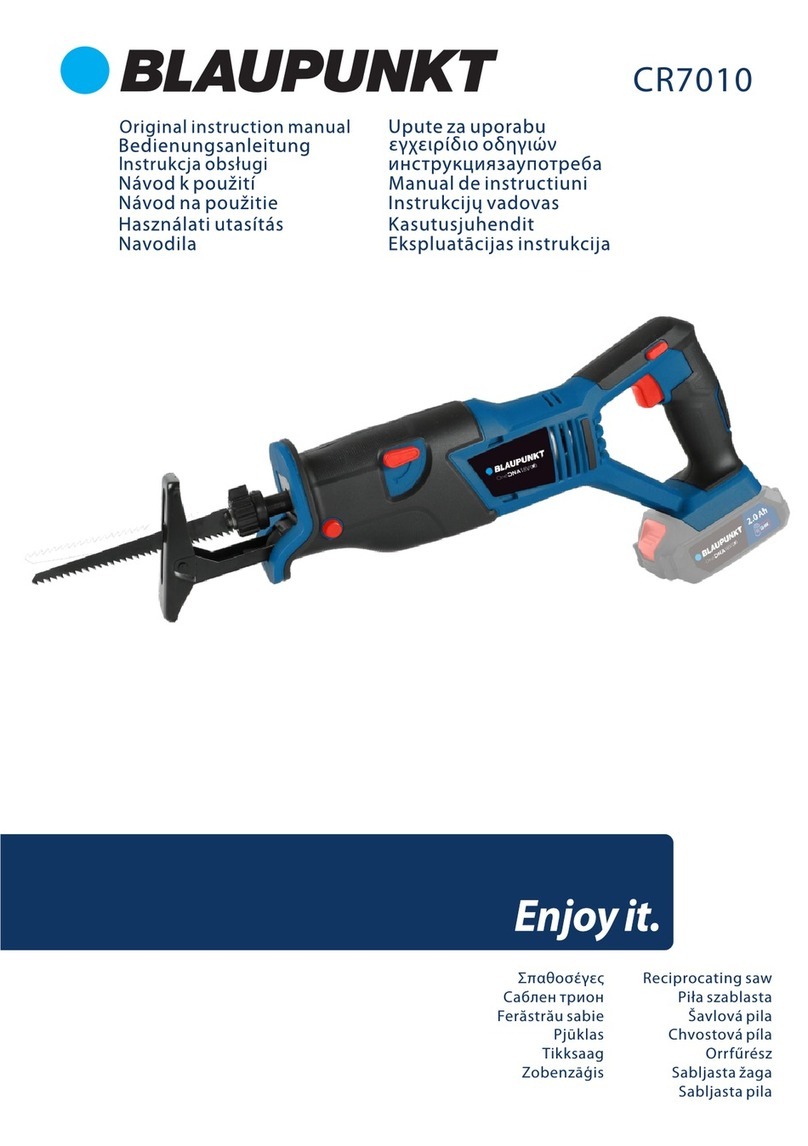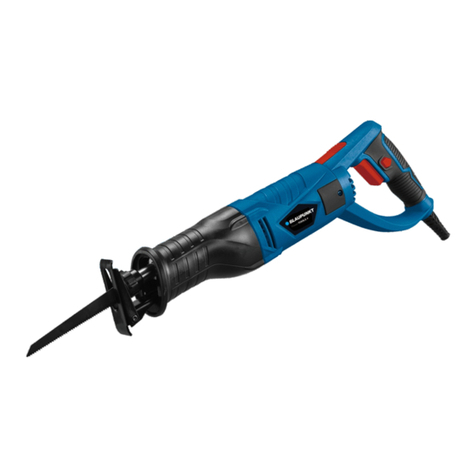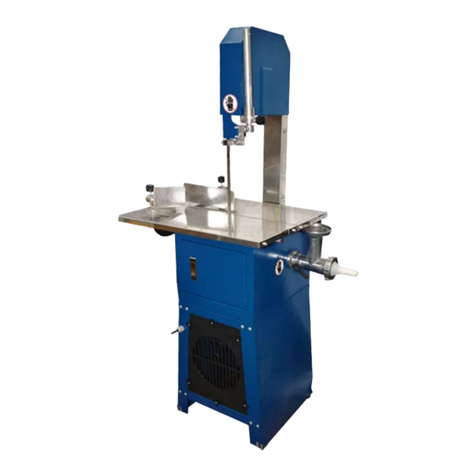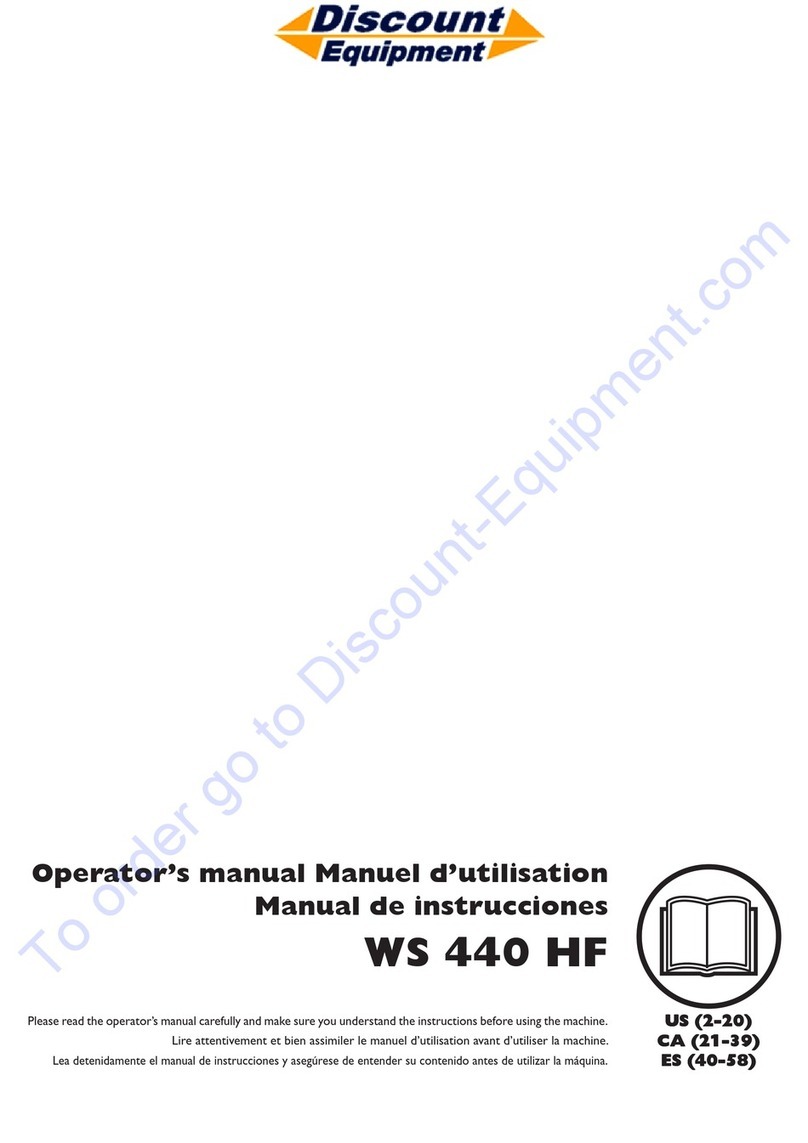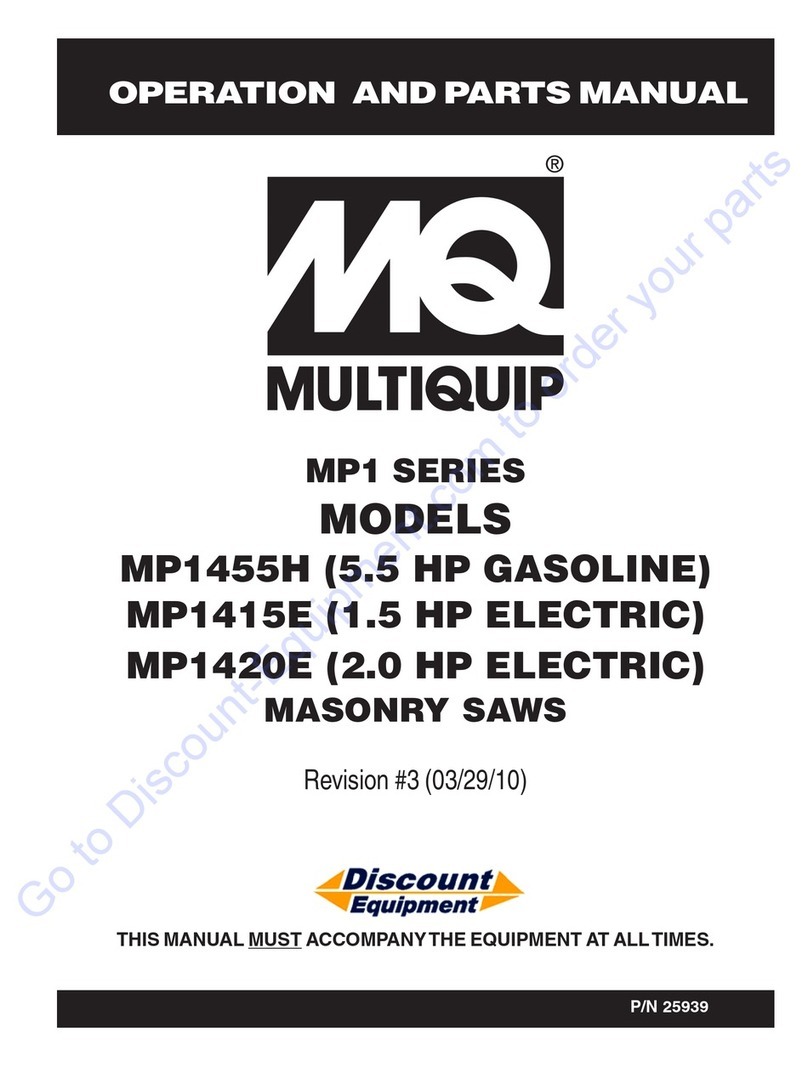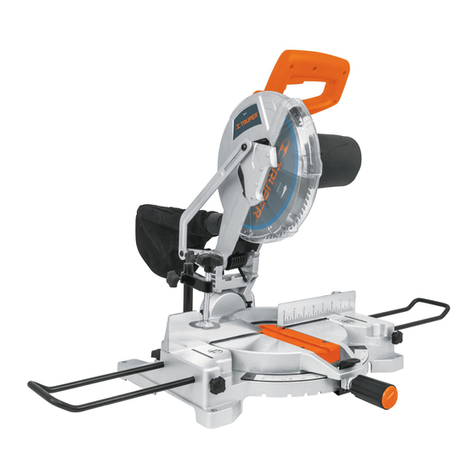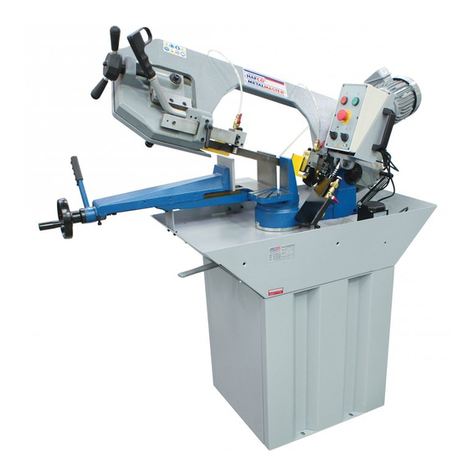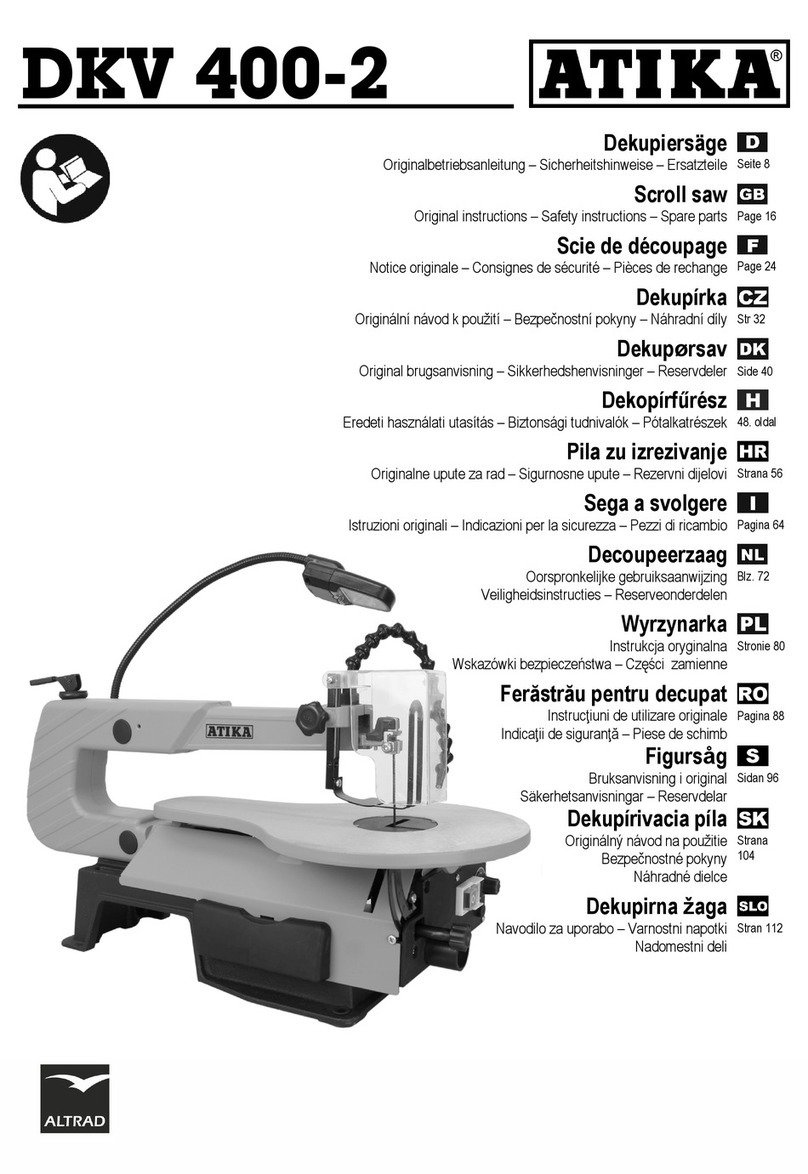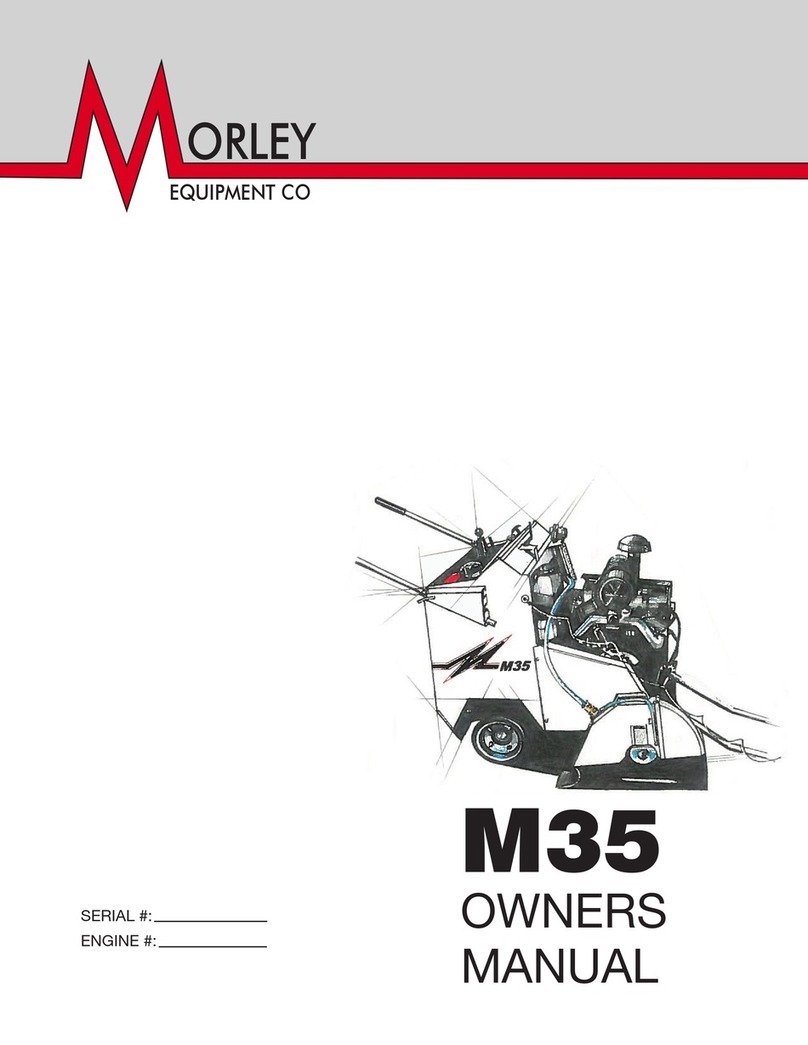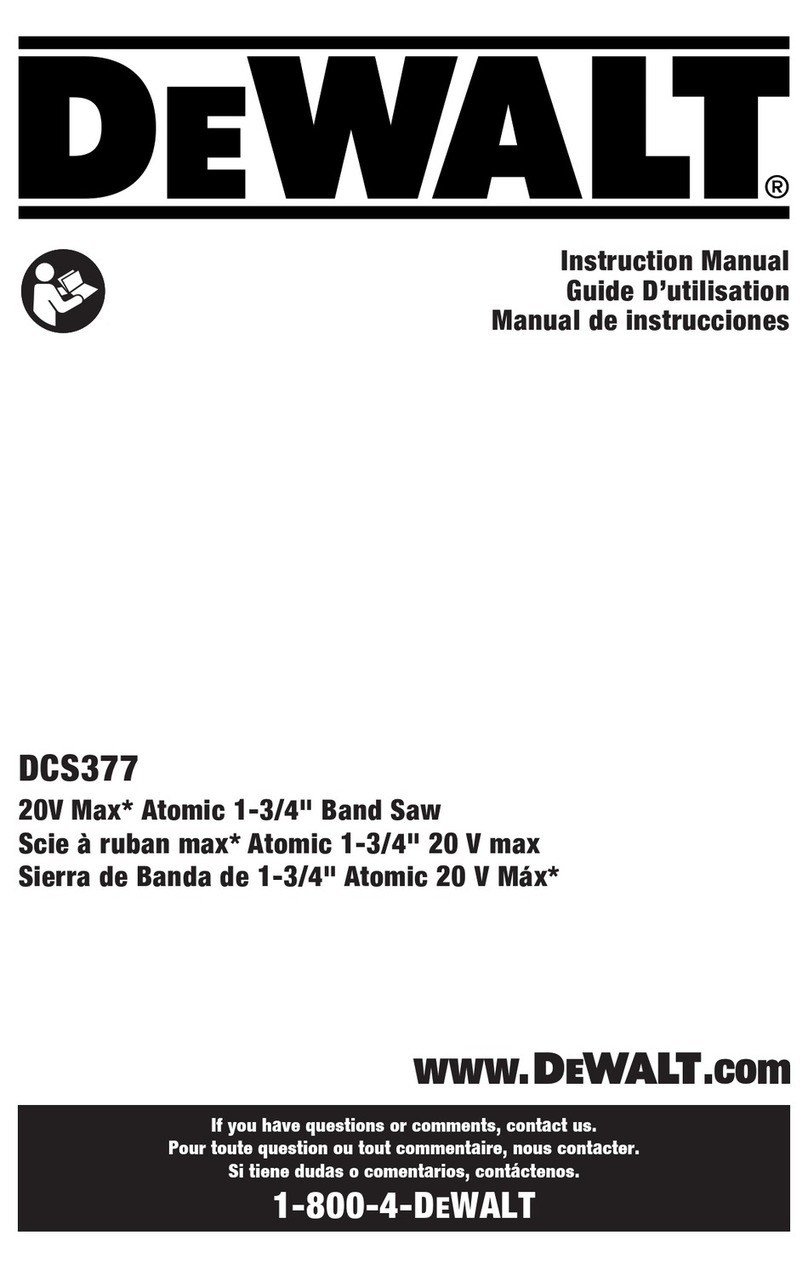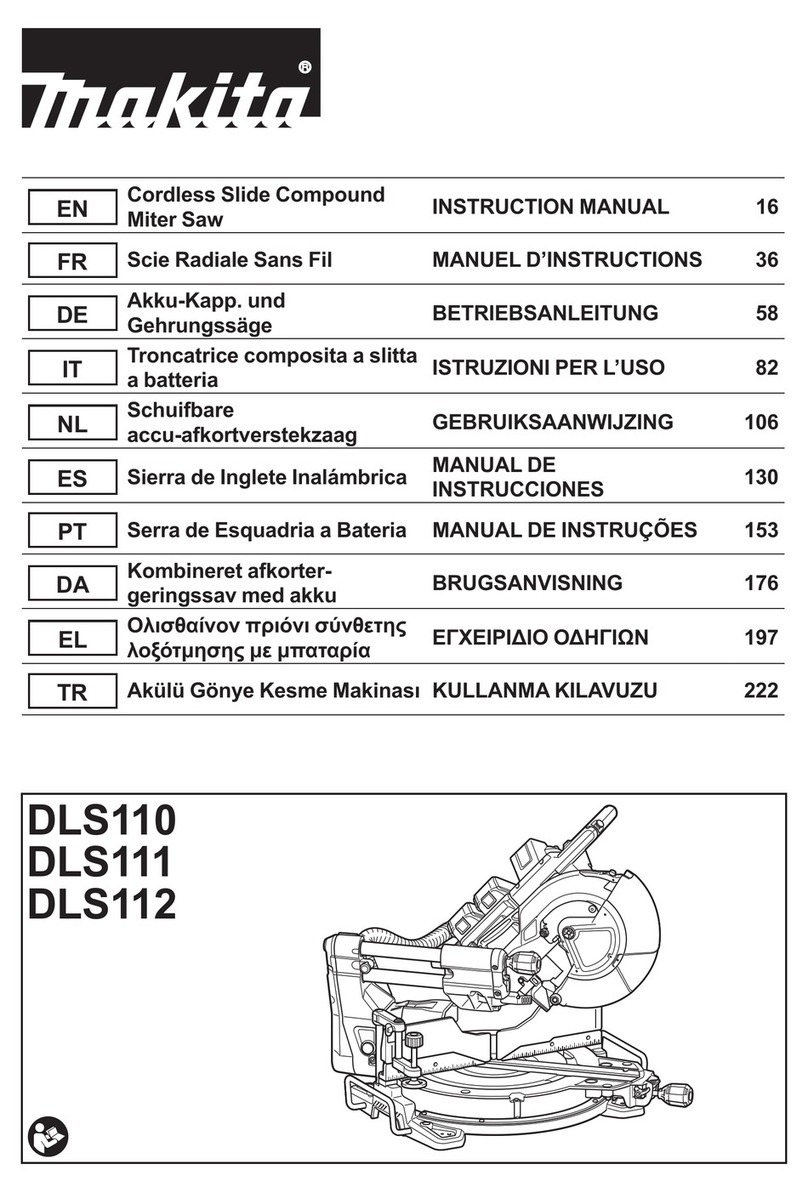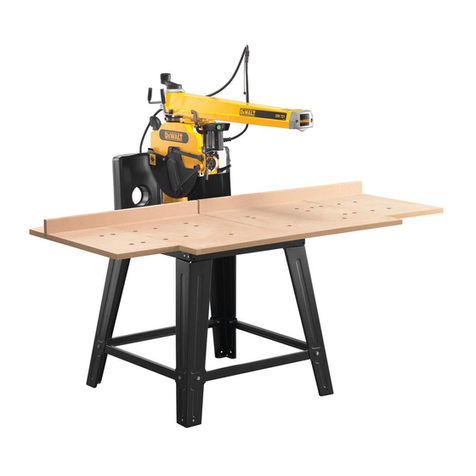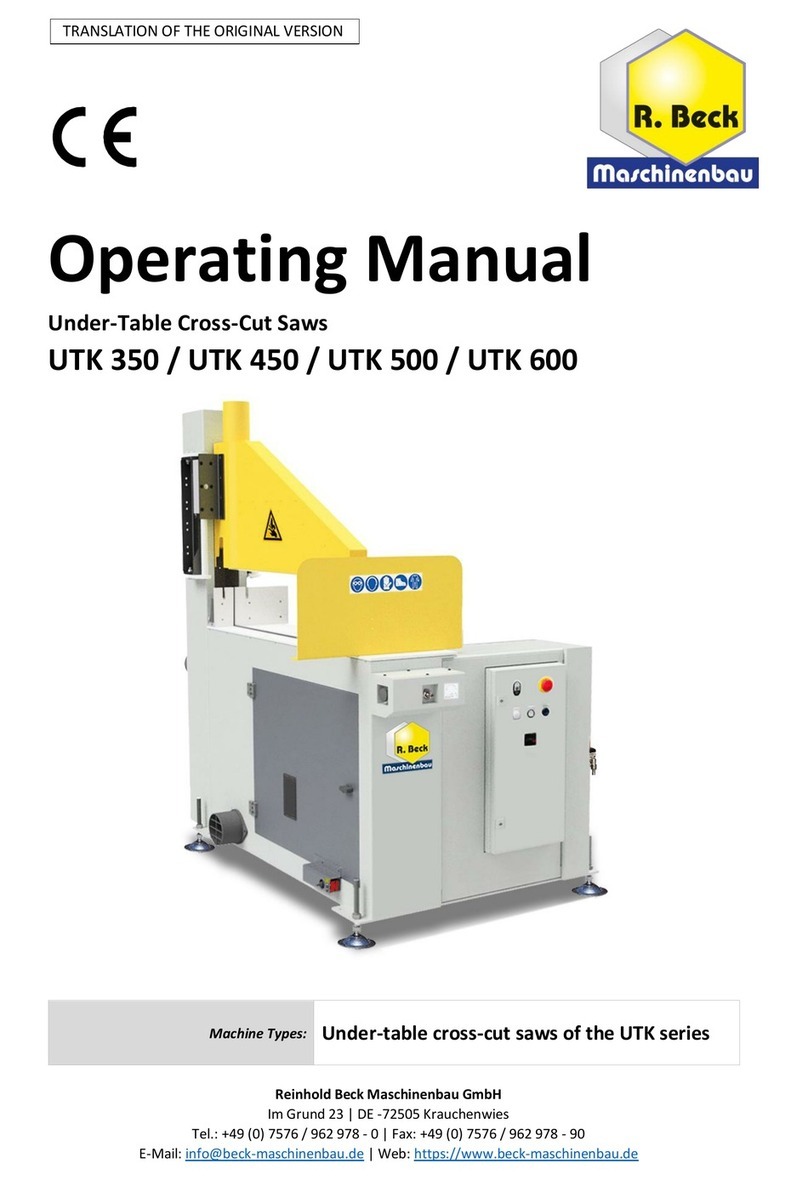Blaupunkt CC5010 User guide

CC5010
Akumulatorowa pilarka tarczowa
Акумулаторен циркуляр
Akumulátorová kotoučová pila
Δισκοπρίονο μπαταρίας
Ferăstrău circular cu acumulator
Akumulatorska kružna pila
Akumuliatorinis diskinis pjūklas
Akkus körfűrész
Cordless Circular Saw
Akumulatora ripzāģis
Akutoitega ketassaag
Akumulátorová kotúčová píla
Akumulatorska krožna žaga

1
19
2
3
4
5
6
7
89
10
11
12
13 16
14
15
18
17
AB

CC5010
IMPORTANT INFORMATION
To achieve the highest satisfaction, enjoy the product's
performance and learn about all its features and functions,
please read this manual before using the product.
Before using the device, read the Operating Instructions and
comply to its contents. The manufacturer shall not be liable for
any damage caused by the use of the device other than for its
intended purpose or by improper handling.
Keep these Operating Instructions for future reference.
• This device is for domestic use only. Do not use for any other
purposes.
• The device should only be connected to an socket with values
corresponding to the values on the rating label.
• It is necessary to check, if total current consumption of all
devices plugged into the wall outlet does not exceed the fuse
in the circuit.
• If you are using an extension cord, make sure that the total
power consumption of the equipment plugged into the
extension cord does not exceed the extension cord power
rating. Extension cords should be arranged in such a way as
to avoid tripping hazards.
• Do not let cord hang over edge of counter, or touch any hot
surface.
• The device is not designed to be controlled via an external
timer, separate remote control, or other equipment that can
turn the device on automatically.
• Before maintenance work always disconnect the unit from
the power supply.
• When unplugging the power cord from electrical outlet, hold
it by the plug only and remove the plug carefully. Never pull
the cable as it may cause damage to the plug or power cord.
Damage to the power cord or plug can lead to an
electrocution hazard.
1

• Never put the power cable, the plug or the whole device into
the water or any other liquids.
• The device should be cleaned regularly complying with the
recommendations described in the section on cleaning and
maintenance.
• Do not place the device near sources of heat, flame, an
electric heating element or a hot oven. Do not place on any
other device.
• The appliance must not be used by children. Keep the
appliance and its cord out of the reach of children.
• The appliance may be used by individuals with limited
physical, sensory or mental capability as well as those
without knowledge of or previous experience in the use of
similar appliances, provided such individuals are supervised
or instructed with regard to the safe operation of the
appliance and are informed about the potential hazards.
• Additional precautions should be taken when using this
device in the presence of children or pets. Do not allow
children to play with the device.
• Never use the product close to combustibles.
• Never expose the product to atmospheric conditions such as
direct sun light or rain, etc... Never use the product in humid
conditions (like bathroom or camping house).
• The power cable should be periodically checked for damage.
If the power cable is damaged the product should be taken to
a professional service location to be fixed or replaced to
prevent any hazards from arising.
• Never use the product with a damaged power cable or if it
was dropped or damaged in any other way or if it does not
work properly. Do not try to repair the defected product by
yourself as it can lead to electric shock. Always return the
damaged device to a professional service in order to repair it.
2
CC5010

All the repairs should only be performed by authorized
service professionals. Any attempted unauthorised repairs
performed can be a hazard to the user.
• Only Original accessories should be used, as well as
accessories recommended by the manufacturer. Using
accessories which are not recommended by the
manufacturer may result in damage of the device and may
render the device unsafe for use.
• Keep your workplace tidy and well lit.
• Disorder and insufficient lighting lead to accidents.
• Do not use power tools in explosive atmospheres, i.e. in the
presence of flammable liquids, gases or dust.
• A moment of carelessness may cause losing control of your
tool.
• If it is possible to fit power tools for dust extraction or
collection, check that they are fitted and working correctly.
Using such power tools reduces the risk posed by the
presence of dust.
• Do not lean out too far when working with your power tool.
Maintain a stable posture and balance. This allows you to
keep better control of your power tool in unforeseen
situations.
• Avoid starting the power tool unintentionally. Make sure the
power switch is in the OFF position before connecting the
power tool to the mains. Carrying a power tool with your
finger on its trigger or plugging in a power tool after
switching it on can lead to accidents.
• Wear appropriate clothing. Do not work in loose clothing and
do not wear jewellery while working. Keep your hair, clothing
and gloves away from moving parts. The moving parts of a
power tool can catch and pull in loose pieces of clothing,
jewellery or long hair.
• Remove any spanners or tools from the power tool before
starting it. A tool or spanner still connected to the rotating
3
CC5010

part of the power tool may cause personal injury.
• Be careful when working with power tools, concentrate on
your work and use common sense. Do not use a power tool
when tired or under the influence of drugs, alcohol or
medication. Even a moment of carelessness while working
with a power tool can lead to a serious accident.
• Keep children away from the work area and DO NOT allow
children to pull on the power cord - this can cause serious
injury.
• Before making any adjustments, changing accessories or
storing the power tool, move the switch to the off position to
disconnect the power tool from the power supply. Such
precautions reduce the risk of accidentally starting the
power tool.
• Ensure that the vents are free from debris.
• The device may only be used in a dry, well-lit environment.
• This tool should not be used by anyone under the age of 16.
• When carrying out work where the tool or clamping
attachment could come into contact with concealed electric
wires, hold the power tool only by insulated surfaces. Contact
of the tool or clamping attachment with a live electrical
conductor may cause voltage to be transmitted to non-
insulated metal parts of the power tool, causing a risk of
electric shock.
• Loss of control of the power tool may result in personal injury.
• Use appropriate detectors to locate the installation or seek
assistance from your local service provider. Contact with live
wires may result in a fire or electric shock. Damage to the gas
tube may lead to an explosion. Bursting of a water pipe leads
to material damage.
• Use only clean and sharp cutting tools (such as drill bits).
Using blunted tools reduces work efficiency and increases
the risk of accidents.
4
CC5010

• Select the operating mode and the work tool according to
the type of the workpiece.
• Check the condition of the dust cover. In the event of
damage, replace it with a new one or send the device to a
professional service centre.
• Working on some materials generates dust that may pose
health risks, cause allergic reactions or respiratory diseases,
and contribute to developing cancer. Ensure good
ventilation at the work station and use dust masks with an
appropriate protection rating.
• Materials containing asbestos must be handled by properly
trained personnel.
• The machine can only be used in indoors with a functioning
ventilation system.
• Take special care when changing the work tool. It can be very
hot and/or sharp immediately after use. It is recommended
to use protective gloves.
Kickback:
The kickback is sudden and uncontrollable, the device reacts to the
jamming or blockage of the cutting device. Jamming or blocking
results in a sudden jerk, in the direction opposite to the rotation of
the disc.
Kickback is the result of not reading the safety instruction.
To avoid kickback, follow the safety instructions and use methods to
prevent it
Methods to prevent kickback.
a) Hold the device by the two handles firmly and securely. Always
use the additional handle. – The operator can control the torque
and the resultant kickback forces if appropriate precautions are
taken.
b) Keep hands away from the cutting part of the device.
CAUTION: The device may injure the user if used improperly.
c) The user should stand in such a position that, in the event of a
CC5010
5

kickback, they are not within reach of the grinder disc.
Safety information
• Do not reach under the workpiece. The guard does not protect
against the blade when cutting the workpiece.
• Set the cutting depth to match the workpiece thickness. There
shall be at least one full blade tooth visible under the workpiece.
• Never hold the workpiece in your hands or on your lap while
cutting. Secure the workpiece to a stable fixture platform.
• Hold the power tool only by the insulated parts of the grip while
handling.
• Always use a length stop or edge guide when cutting long
workpieces. This will improve the quality of cut and reduce the risk
of jamming the saw blade.
• Always use saw blade wheels with the correct size and shape of
bore.
• Large, flat workpieces like panels need to be supported on a
sufficient surface to minimise the risk of jamming the saw blade
and kickback. Panels tend to bend under their weight. Support the
panel workpiece from below, on both sides of the tool, close to the
cut line and near the panel edges.
• Close and secure the blade depth and bevel angle lock levers
before starting to cut. If the blade adjustment moves during a cut,
the blade can be jammed and kicked back.
• Make sure that the lower guard is securely closed before each use.
Do not use the saw if the guard does not move freely and does not
close immediately. Never clamp or fix the lower guard open in any
way. If the saw is accidentally dropped, the blade may bend. Lift
the lower guard using the retractable handle and ensure that the
guard moves freely and does not touch the blade or any other part
at any bevel angle or depth of cut.
• Retract the lower guard by hand only during specific cutting
patterns, like plunge cuts and compound cuts. Raise the lower
guard by pulling back the handle and as soon as the blade cuts into
the workpiece material, release the lower guard. For all other
processing, the lower guard must operate automatically.
• Never use a buzz saw held with the blade upwards. This is very
CC5010
6

dangerous and may result in severe injury.
• Handle the saw with both hands when operating.Any modification
or alteration of the power tool or its battery pack is prohibited.
Charger and battery pack safety instructions
To connect the battery pack for charging, insert the battery pack
into the charger dock and plug the charger to a power source.
• Keep the charger away from rain and moisture. The charger may
only be used indoors.
• Keep the charger clean.
• Do not operate the charger on readily combustible objects and
surfaces (e.g. paper) or areas with flammable/explosive
atmospheres.
• Always ensure adequate ventilation when charging; fumes or
battery acid can be released from the battery pack if the latter is
compromised by poor handling or damage.
• When charging is complete, unplug the charger from the power
source. Do not leave it connected to a power source for longer than
necessary.
• Store and charge the battery pack in a dry place and make sure it
will not be flooded by water.
• Keep the battery pack terminals clean and free of dirt.
• Protect the battery pack from shocks and moisture; never open the
battery pack or expose it to any damage.
The battery pack charge level can be displayed with the number of
charge indicator LEDs by pressing the state of charge indicator
button on the pack; if required, charge the battery pack for as long
as required to reach the desired charge level and the expected
operating time of the cordless power tool.
CC5010
7

SYMBOLS
• The following symbols may appear in the operating instructions or on the tool’s nameplate.
• These signs contain important information about the product and instructions on how to use it.
WEAR PERSONAL PROTECTIVE EQUIPMENT
• Wear safety glasses according to En166
• Use protective masks in accordance with En149
• Use other types of proper personal protective equipment, depending on the type of work involved.
Description of the device
8
Read the user manual.
Use ear protection
Wear protective glovesGeneral warning
Wear protective clothing
Wear a protective mask
Wear safety glasses
Fire hazard
Wear respiratory protection
Electric shock hazard
1. Bevel angle lever (0° - 50°)
2. Saw base
3. Cut line
4. Hose
5. Dust extraction port
6. Vacuum cleaner
7. Cutting depth lever
8. Trigger lock
9. Trigger switch
10. Allen key
11. Saw wheel
12. Outer flange
13. Retaining bolt
14. Battery pack latch release button
15. Battery pack
16. Inner flange
17. State of charge indicator button
18. Battery charge indicator
19. Saw wheel lock button
CC5010

9
Storage
Store cordless tools in a dry place and out of the reach of children. For safety concerns, remove the
battery pack from the cordless tool before storage. When left connected to a cordless tool, the battery
pack is drained faster. Protect the battery pack and power tools from frost, high temperatures,
moisture and water.
Do not attempt to repair a failed battery pack. Only the original manufacturer or an authorised service
may repair the battery pack.
Recharge the battery packs using only the chargers specified by the manufacturer.
Storage or operation of the battery pack in unsuitable conditions may result in a battery acid leak.
Never attempt to use a damaged or modified battery pack. Damaged or modified battery packs may
cause unpredictable effects during operation, resulting in health hazards. Keep the battery pack away
from open flames and high temperature. If exposed to fire or temperatures above 130°C, the battery
pack may explode.
Installing the battery pack
Tip: Using a battery pack incompatible with the power tool may result in abnormal performance or
failure of the power tool.
Insert the battery pack into the handle until the battery pack latch clicks (the battery pack should be
flush with the receptacle edges on the power tool).
Operation
1. Use the lever (1) to set the bevel angle.
2. The cutting line “A” is for the bevel angle set to 0°. The cutting line “B” is for the bevel angle set to 50°.
3. The tool can be connected to a dust extractor to remove dust and debris from the work area.
4. Use the lever (7) to set the depth of cut.
5. Turn on the power tool by pressing the trigger switch (9) while pressing and holding the trigger lock
(8).
6. To replace the saw wheel, use the Allen key (10) and the saw wheel lock button (19) to remove the
saw wheel and replace it with a new one.
7. A 4 Ah battery pack is recommended.
CLEANING AND MAINTENANCE
Before cleaning and maintenance, make sure the device is disconnected from the power source.
Keep the ventilation apertures (air inlets and outlets) of the device free of dirt. Wipe the device with a
dry cloth or blow it with compressed air. Keep the work tool chuck free of dust. It is recommended to
clean the device after each use. Do not immerse in water or other liquids. Do not use aggressive
cleaning agents or solvents.
Noise
Typical A-weighted noise level measured in accordance with En62841:
Sound pressure level (LpA): 95 dB (A)
Measurement uncertainty (K): 3 dB (A)
Noise level during operation may exceed: 106 dB (A).
Wear hearing protection!
Vibrations
Total vibration value measured in accordance with EN 62841:
Vibration emission: ah,W = 2,5 m/s² ;
Measurement uncertainty (K): 1,5 m/s²
Weight 2.2 kg
CC5010

CC5010
Permissible Operating Time: 15 minutes of operation, 30 minutes off.
The declared vibrations has been measured according to the standard test method and can be used to
compare tools.
The declared vibrations can also be used in the initial exposure assessment.
Cordless Circular Saw
Voltage: 18 V
Maximum blade diameter: 165 mm
No-load speed: 3650 rpm
Maximum bevel angle: 50°
Max. cutting depth: 90° – 50 mm; 50° – 35 mm
Steel shoe
Accessories: 1 x hex wrench, 1 x guide rail
Battery type: 18 V Li-Ion; BP1840 4.0 Ah recommended (not included)
Dimensions: 32 x 19 x 23.5 cm
Weight: 2.2 Kg
10

WAŻNE INFORMACJE
Aby osiągnąć najwyższą satysfakcje, cieszyć się wydajnością
produktu i poznać jego wszystkie cechy i funkcje, prosimy o
przeczytanie niniejszej instrukcji przed przystąpieniem do
korzystania z tego produktu.
Przed rozpoczęciem użytkowania urządzenia przeczytać
instrukcję obsługi i postępować według wskazówek w niej
zawartych. Producent nie odpowiada za szkody spowodowane
użytkowaniem urządzenia niezgodnie z jego przeznaczeniem
lub niewłaściwą jego obsługą.
Instrukcję obsługi należy zachować, aby można było korzystać
z niej również w trakcie późniejszego użytkowania wyrobu.
• Urządzenie należy podłączyć wyłącznie do gniazdka z
uziemieniem o charakterystyce zgodnej z wartościami na
tabliczce znamionowej.
• Należy sprawdzić, czy całkowity pobór prądu wszystkich
urządzeń podłączonych do gniazdka ściennego nie
przekracza maksymalnego obciążenia bezpiecznika.
• Jeżeli wykorzystywany jest przedłużacz, należy sprawdzić,
czy łączny pobór mocy sprzętu podłączonego do
przedłużacza, nie przekracza parametrów obciążenia
przedłużacza. Przewód przedłużacza należy ułożyć w taki
sposób by uniknąć przypadkowych pociągnięć i potknięcia
się o niego. Upewnij się, że przedłużacz jest z uziemieniem, 3-
żyłowy z gniazdkiem z bolcem uziemiającym.
• Urządzenie nie jest przeznaczone do sterowania za pomocą
zewnętrznego wyłącznika czasowego, osobnego pilota lub
innego sprzętu, który może włączać urządzenie
automatycznie.
• Przed pracami konserwacyjnymi należy zawsze
bezwzględnie odłączyć urządzenie od zasilania. Odłączając
kabel zasilający należy zawsze wyciągać go z gniazdka
trzymając za wtyczkę. Nigdy nie należy wyciągać przewodu
zasilającego ciągnąc za kabel, ponieważ uszkodzeniu może
POLSKI
11
CC5010

ulec wtyczka lub kabel, w skrajnym wypadku może dojść
nawet do śmiertelnego porażenia prądem.
• Nie zanurzaj urządzenia w wodzie lub żadnym innym płynie.
• Urządzenie powinno być regularnie czyszczone według
zaleceń opisanych w części o Czyszczeniu i konserwacji
urządzenia.
• Nie umieszczaj urządzenia blisko źródeł ciepła, płomieni,
elektrycznego elementu grzewczego lub na gorącym
piekarniku. Nie umieszczaj na żadnym innym urządzeniu.
• Należy zachować szczególną ostrożność podczas korzystania
z urządzenia, gdy w pobliżu przebywają dzieci lub zwierzęta
domowe.
• Nie należy dopuszczać dzieci do zabawy urządzeniem.
• Nie korzystać z urządzenia w pobliżu materiałów
łatwopalnych.
• Nie wystawiaj urządzenia na działanie warunków
atmosferycznych (deszczu, słońca, etc.) ani nie używaj w
warunkach podwyższonej wilgotności (łazienki, wilgotne
domki kempingowe).
• Okresowo sprawdzaj stan przewodu zasilającego. Jeżeli
przewód zasilający nieodłączalny ulegnie uszkodzeniu, to
powinien on być wymieniony u wytwórcy lub w
specjalistycznym zakładzie naprawczym albo przez
wykwalifikowaną osobę w celu uniknięcia zagrożenia.
• Nie używaj urządzenia z uszkodzonym przewodem
zasilającym, wtyczką lub jeśli zostało upuszczone lub
uszkodzone w jakikolwiek inny sposób lub nieprawidłowo
pracuje. Nie naprawiaj urządzenia samodzielnie, gdyż grozi
to porażeniem. Uszkodzone urządzenie oddaj do właściwego
punktu serwisowego w celu sprawdzenia lub dokonania
naprawy. Wszelkich napraw mogą dokonywać wyłącznie
uprawnione punkty serwisowe. Nieprawidłowo wykonana
naprawa może spowodować poważne zagrożenie dla
12
CC5010

użytkownika.
• Używaj tylko oryginalnych akcesoriów oraz części
zamiennych do urządzenia lub rekomendowanych przez
producenta. Używanie akcesoriów lub części
nierekomendowanych przez producenta może doprowadzić
do uszkodzenia urządzenia oraz zagrozić bezpieczeństwu
użytkowania.
• Dbaj o porządek i dobre oświetlenie w miejscu pracy.
• Nieporządek i niewystarczające oświetlenie prowadzą do
wypadków.
• Nie używaj elektronarzędzi w przestrzeniach zagrożonych
wybuchem, tj. w obecności łatwopalnych cieczy, gazów lub
pyłów.
• Chwila nieuwagi grozi utratą panowania nad narzędziem.
• Jeżeli istnieje możliwość zamontowania elektronarzędzi do
odprowadzania lub zbierania pyłu, sprawdź, czy zostały one
zamocowane i działają prawidłowo. Używanie takich
elektronarzędzi zmniejsza zagrożenie stwarzane przez
obecność kurzu.
• Nie wychylaj się z elektronarzędziem zbyt daleko. Utrzymuj
stabilną postawę i równowagę. Dzięki temu zachowasz
lepszą kontrolę nad elektronarzędziem w nieprzewidzianych
sytuacjach.
• Unikaj niezamierzonego uruchomiania elektronarzędzia.
Przed podłączeniem elektronarzędzia do sieci elektrycznej
sprawdź, czy wyłącznik zasilania znajduje się w położeniu
wyłączonym (OFF). Przenoszenie elektronarzędzia z palcem
na spuście lub podłączanie elektronarzędzia do sieci już po
włączeniu może prowadzić do wypadków.
• Zakładaj odpowiednią odzież. Nie pracuj w luźnym ubraniu i
nie noś biżuterii podczas pracy. Włosy, odzież i rękawice
trzymać z dala od ruchomych części. Ruchome części
elektronarzędzia mogą pochwycić i wciągnąć luźne części
odzieży, biżuterię lub długie włosy.
• Przed uruchomieniem elektronarzędzia wyjmij z niego
POLSKI
13
CC5010
POLSKI

wszystkie klucze lub narzędzia. Narzędzie lub klucz nadal
połączony z częścią obrotową elektronarzędzia może
spowodować obrażenia ciała.
• Podczas pracy z elektronarzędziami zachowuj ostrożność,
skoncentruj się na pracy i stosuj zdrowy rozsądek. Nie używaj
elektronarzędzia w razie zmęczenia lub pod wpływem
środków odurzających, alkoholu lub leków. Nawet chwila
nieuwagi podczas pracy z elektronarzędziem grozi
poważnym wypadkiem.
• Trzymaj dzieci z dala od miejsca wykonywania pracy i NIE
pozwalaj dzieciom na pociąganie za kabel zasilający – może
to spowodować poważne obrażenia.
• Przed dokonaniem jakichkolwiek regulacji, wymianą
akcesoriów lub odstawieniem elektronarzędzia do
przechowania przestaw wyłącznik do położenia wyłączenia,
aby odłączyć elektronarzędzie od zasilania. Takie działania
zapobiegawcze zmniejszają ryzyko przypadkowego
uruchomienia elektronarzędzia.
• Upewnij się, że otwory wentylacyjne są wolne od osadów.
• Z urządzenia można korzystać wyłącznie w suchym, dobrze
oświetlonym otoczeniu.
• Z tego narzędzia nie powinny korzystać osoby poniżej 16
roku życia.
• Podczas wykonywania prac, przy których narzędzie lub
element mocujący mogłyby natrafić na ukryte przewody
elektryczne, elektronarzędzie należy trzymać wyłącznie za
izolowane powierzchnie. Kontakt narzędzia lub elementu
mocującego z przewodem elektrycznym pod napięciem
może spowodować przekazanie napięcia na nieizolowane
części metalowe elektronarzędzia, grożąc porażeniem
prądem elektrycznym.
• Utrata kontroli nad elektronarzędziem może spowodować
obrażenia ciała.
14
CC5010

• Należy używać odpowiednich detektorów w celu
zlokalizowania instalacji lub zwrócić się o pomoc do
lokalnego dostawcy usługi. Kontakt z przewodami
znajdującymi się pod napięciem może doprowadzić do
powstania pożaru lub porażenia elektrycznego. Uszkodzenie
przewodu gazowego może doprowadzić do wybuchu.
Przebicie przewodu wodociągowego powoduje szkody
rzeczowe.
• Należy stosować tylko czyste i ostre narzędzia tnące (np.
wiertła). Użycie tępych narzędzi zmniejsza efektywność
pracy oraz zwiększa ryzyko wypadków.
• Należy wybrać tryb pracy i narzędzie robocze odpowiednio
do rodzaju obrabianego materiału.
• Sprawdzać stan osłony przeciwpyłowej. W przypadku jej
uszkodzenia, należy wymienić ją na nową lub oddać
urządzenie do profesjonalnego punktu serwisowego.
• Przy obróbce niektórych materiałów w powietrze wzbijane są
pyły, które mogą stanowić zagrożenie dla zdrowia,
wywoływać reakcje alergiczne, schorzenia dróg
oddechowych, przyczyniać się do zachorowań na raka.
Należy dbać o dobrą wentylacje stanowiska pracy oraz
stosować maski przeciwpyłowe o odpowiedniej klasie
ochrony.
• Materiały zawierające azbest mogą być obrabiane jedynie
przez odpowiednio przeszkolony personel.
• Maszyna może być użytkowana tylko w pomieszczeniach
zamkniętych o sprawnie działającej wentylacji.
• Zachować szczególną ostrożność podczas wymiany
narzędzia roboczego. Bezpośrednio po użyciu może być
bardzo gorące i/lub ostre. Zaleca się używania rękawic
ochronnych.
CC5010
POLSKI
15

Zjawisko odrzutu:
Ÿ Odrzut jest nagły i niekontrolowany, reakcja urządzenia na
zakleszczenie lub zablokowanie urządzenia tnącego.
Zakleszczenie lub zatrzymaniem skutkuje gwałtownym
szarpnięciem, w kierunku przeciwnym do obrotu tarczy.
Ÿ Odrzut jest skutkiem nie zapoznania się z instrukcją
bezpieczeństwa.
Ÿ By uniknąć zjawiska odrzutu postępuj zgodnie z instrukcją
bezpieczeństwa oraz zastosuj metody zapobiegania zjawiska
odrzutu.
Metody zapobiegania zjawisku odrzutu.
a) Urządzenie należy trzymać za dwa uchwytu mocno i pewnie.
Zawsze należy używać uchwytu dodatkowego. – Osoba
operująca urządzeniem może kontrolować moment
obrotowy i związany z nim siły odrzutu, jeżeli podejmie
odpowiednie środki ostrożności.
b) Należy trzymać ręce z dala od tnącej części urządzenia.
UWAGA: Urządzenie przy niewłaściwym użytkowaniu może
uszkodzić ciało użytkownik.
c) Osoba korzystająca z urządzenia powinna ustawić się w taki
sposób by przy zjawisku odrzutu nie była w zasięgu ostrza
szlifierki.
Informacje dotyczące bezpieczeństwa
1. Nie należy sięgać pod obrabiany przedmiot. Osłona nie
chroni osoby przed ostrzem podczas cięcia przedmiotu.
2. Należy dostosować głębokość cięcia do grubości
obrabianego przedmiotu. Pod obrabianym przedmiotem
powinien być widoczny minimum pełny ząb ostrza.
3. Nigdy nie należy trzymać ciętego elementu w dłoniach lub
na nogach. Należy przymocować obrabiany przedmiot do
stabilnej platformy.
4. Trzymać elektronarzędzie wyłącznie za izolowane
CC5010
16

powierzchnie uchwytu podczas wykonywania czynności.
5. Podczas cięcia dłuższego elementu zawsze należy używać
ogranicznika wzdłużnego lub prowadnicy krawędziowej.
Poprawia to dokładność cięcia i zmniejszy ryzyko
zakleszczenia się ostrza.
6. Zawsze należy używać ostrzy o odpowiednim rozmiarze i
kształcie otworu.
7. Należy podeprzeć duże panele, aby zminimalizować ryzyko
zakleszczenia ostrza i odrzutu. Duże panele mają tendencję
do uginania się pod własnym ciężarem. Podpory należy
umieścić pod płytą z obu stron, w pobliżu linii cięcia oraz w
pobliżu krawędzi płyty.
8. Dźwignie blokady regulacji głębokości ostrza i kąta muszą
być dokręcone i zabezpieczone przed rozpoczęciem cięcia.
Jeśli regulacja ostrza przesunie się podczas cięcia, może to
spowodować zakleszczenie i odrzut.
9. Przed każdym użyciem sprawdzić, czy dolna osłona zamyka
się prawidłowo. Nie należy używać piły, jeśli dolna osłona nie
porusza się swobodnie i nie zamyka się natychmiast. Nigdy
nie zaciskać ani nie wiązać dolnej osłony w pozycji otwartej.
Jeśli piła zostanie przypadkowo upuszczona, ostrze może się
wygiąć. Należy podnieść dolną osłonę za pomocą
chowanego uchwytu i upewnić się, że porusza się
swobodnie i nie dotyka tarczy ani żadnej innej części pod
żadnym kątem i na każdej głębokości cięcia.
10. Dolną osłonę należy wsuwać ręcznie tylko w przypadku cięć
specjalnych, takich jak „cięcie wgłębne” i „cięcie złożone”.
Należy podnieść dolną osłonę przez cofnięcie uchwytu i jak
tylko ostrze wejdzie w materiał, dolna osłona musi zostać
zwolniona. W przypadku wszystkich innych prac dolna
osłona powinna działać automatycznie.
11. Nigdy używać pilarki tarczowej trzymanej w pozycji
ostrzem ku górze. Jest to bardzo niebezpieczne i może
prowadzić do poważnych wypadków.
CC5010
POLSKI
17

12. Podczas pracy z urządzeniem należy pamiętać o
korzystaniu z pilarki oburącz.
13. Wszelkie modyfikacje, przeróbki urządzenia/akumulatora
są zabronione.
Instrukcje dotyczące bezpieczeństwa ładowarki i
akumulatora
Aby podłączyć akumulator do ładowania należy go wsunąć w
ładowarkę, a następnie ładowarkę podłączyć do źródła
zasilania.
• Chroń ładowarkę przed deszczem i wilgocią. Ładowarka może
być używana wyłącznie w pomieszczeniach.
• Utrzymuj ładowarkę w czystości.
• Nie używaj ładowarki na łatwopalnych przedmiotach i
podłożach (np. papierze) ani w środowiska z atmosferą
wybuchową i/lub łatwopalną.
•Zawsze zapewniaj odpowiednią wentylację podczas
ładowania, ponieważ opary lub elektrolit mogą wyciekać z
akumulatora, jeśli akumulator jest uszkodzony w wyniku
niewłaściwego obchodzenia się z nim/uszkodzenia.
• Po zakończeniu ładowania odłącz ładowarkę od gniazdka
ściennego. nie pozostawiaj go podłączonego do źródła
zasilania dłużej niż to konieczne.
• Przechowuj i ładuj akumulator w suchym miejscu i upewnij
się, że nie dostanie się do niego woda.
• Utrzymuj złącza baterii w czystości i wolne od zabrudzeń.
• Chroń akumulator przed wstrząsami, wilgocią i nigdy nie
otwieraj ani nie uszkadzaj mechanicznie akumulatora.
Aby sprawdzić poziom naładowania akumulatora, należy
nacisnąć przycisk na akumulatorze i w razie potrzeby
naładować akumulator zgodnie z liczbą diod LED i
przewidywanym czasem pracy narzędzia bezprzewodowego.
CC5010
18
Table of contents
Languages:
Other Blaupunkt Saw manuals
